Musicarta Pentatonics Workbook
The Major and Relative Minor Pentatonic Scale Pairs
The five notes of every pentatonic major scale, starting on a different note, provide the five scale-tones of a corresponding – or 'relative' – pentatonic minor scale.
So for every group of five scale-tones, you get two scales, one major and one minor.
Here's a keyboard drill that will help you see-and-hear that straight off. It's easy enough to just copy from the video, if not the first time, then definitely the second time through.
Finding the major/relative minor scale pairs
Here's the method for counting and rehearsing the major/relative minor pairs of scales.
The scale pairs to practice
The pentatonic scales group themselves nicely by the number of black keys they use – there are six all-white-key pentatonic scales, three major and three minor, then two major and two minor pentatonic scales with just one black piano key, another four scales with two black keys, and so on.
This provides a nice
way to structure your practice. For example, you could learn and revise a group a week, and play all your pentatonic scale-tone practice patterns in the week's keys
Remember, brass instruments play in B and E flat, while the easiest major chord to play on a guitar is probably E major – four sharps on the piano/three black keys in the pentatonic scale. We have to push beyond easy all-white-key territory!
Working methodically through this whole set of drills (more than once!) will teach you a great deal about what the keyboard sounds like, and get your keyboard creativity off to a flying start.
Note: For the sake of clarity, the minor 3rd and minor 7th in the minor scales are labelled simply '3' and '7' on the keyboard. You are reminded of this periodically.
Group 1: No black keys
C major and relative A minor
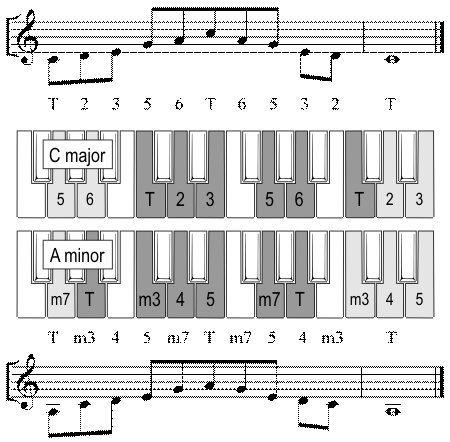
G major and relative E minor
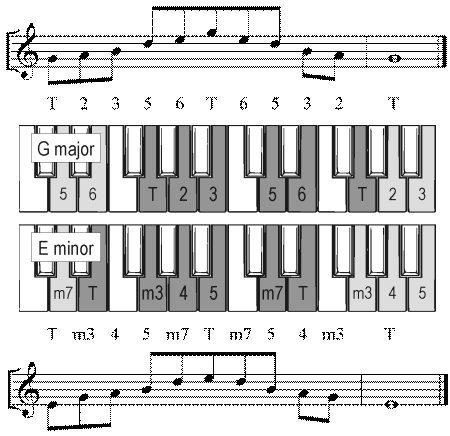
F major and relative D minor
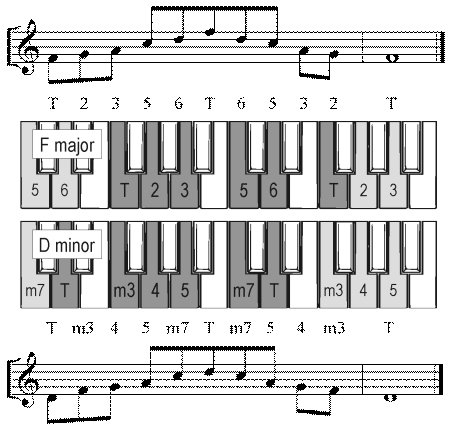
Group2: One black key
D major and B minor
Key signatures are not shown; the black keys are indicated in the music.
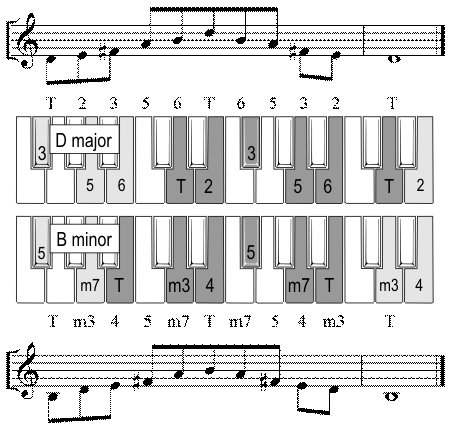
B flat major and G minor
The black keys are indicated in the music.
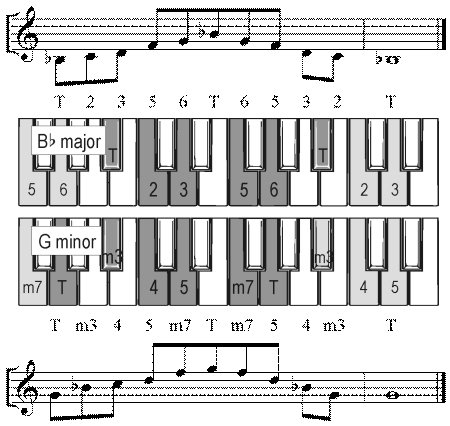
Group 3: Two black keys
A major and F© minor
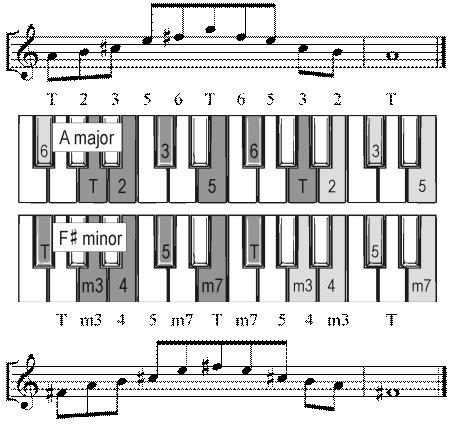
E flat major and C minor
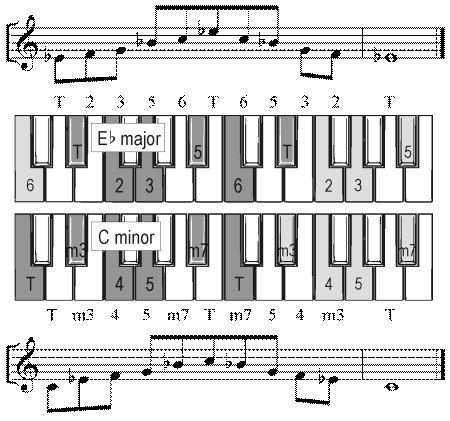
Group 4: Three black keys
Pentatonic scales which use three black keys are the classical major and minor keys with four accidentals in the key signature: E major and C sharp minor, and A flat major and F minor.
Groups 5 and 6: Four and five black keys
Pentatonic scales which use four black keys are the classical major and minor keys with five accidentals in the key signature: B major and G sharp minor, and D flat major and B flat minor.
An obscure theoretical point you don't in any way need to remember:
When you get to six accidentals in the key signature (maximum possible five black keys in the pentatonic scale), there is only one pair: G flat major ('enharmonic' F sharp major) and relative E flat minor (enharmonic D sharp minor).
This all-black-key scale is difficult to play and quite unnecessary, and has been largely ignored in the Musicarta Pentatonics Workbook.
The notes of the pentatonic scale
The notes (scale tones) of the major pentatonic scale are:
- The tonic, the major second, the major third, the perfect fifth, and the major sixth
(The fourth and seventh notes of the major scale are missed out.)
The notes (scale tones) of the minor pentatonic scale are:
- The tonic, the minor third, the perfect fourth, the perfect fifth, and the minor (or flattened) seventh.
(The second and sixth of the natural minor scale are missed out.)
The shorthand for the pentatonic scale tones used in this workbook is:
Note that in the shorthand, ‘major’ (the second, third and sixth) and ‘perfect’ (the fourth and fifth) are understood, and not written down.
You can use the shorthand to find the pentatonic tones just by counting the piano keys from T = 1, but only for white-key C, G, and F major, and A, E, and D minor pentatonic scales. After that you need black keys, and you have to know your scales.
One-octave pentatonic scales in written music
Play these one-octave major and minor pentatonic scales.
First, revise the pentatonic scale tone shorthand:
The music says to play from one tonic (T) up to the next tonic then back down again.
To avoid having to think about fingering, use two hands – the left hand for the bottom three notes and the right hand for the top three. The stems of the left hand notes are shown pointing down, and pointing up for the right hand notes.
Use any fingers that are convenient. The purpose of the drill is to start to recognise the sound of the two pentatonic scales and to ‘see’ them on the keyboard. As soon as you can, watch your hands playing the scale tones on the keyboard, rather than looking at the written page.
Notice that the keyboards no longer line up with the music. You have to think about where T is, which keys to skip, and match up the scale tone shorthand above and below the music with the shorthand on the keyboard.
Finding the tonic
Melodies often start and end on the tonic (name-note) of the key the piece is in. If you are improvising, or just ‘messing about’ creatively on the pentatonic scale, it pays to know which note the tonic is.
There are five notes in a pentatonic scale. Two of the seven normal scale tones in the octave are skipped, leaving gaps. That leaves the remaining five notes grouped into one group of two notes and one group of three notes. The same groups are used for two pentatonic scales, one major and one the relative minor.
Here’s how to find the tonic in those groups of three and two notes
- The tonic of the major pentatonic scale is the lowest of every group of three notes.
- The tonic of the minor pentatonic scale is the highest of every group of two notes.
The tonics are marked with a T on the keyboards in the workbook keyboard diagrams. Check to see how they follow the description given.
Here are the tonics of the three pairs of pentatonic scales marked on less cluttered keyboards – major tonics above and minor tonics below. Doodle around and between tonics to improve your ‘ear’ for the home note of the two scales.
C and A minor
major tonics

minor tonics
G and E minor
major tonics

minor tonics
F and D minor
major tonics

minor tonics
You have to pay close attention to the groups of black keys on your keyboard to see where the notes of these white-keys-only pentatonic scales are.
The groups of two and three notes are much less obvious in the pentatonic scales that use black keys. In time, you will be able to see the groups just as clearly.
|
OUT NOW! |
THE MUSICARTA BEAT & RHYTHM WORKBOOK At last! An effective approach to keyboard rhythm & syncopation skills. Learn more! |
ONLY $24.95! |
|
THE MUSICARTA PENTATONICS WORKBOOK video course Home/Index pages The Pentatonic Scales
Practice Patterns
Melody Work and
Playing by Ear
Pentatonic Riffs
and Diaries - Minor Pentatonic Major Pentatonic
Chromatic Minor
Chromatic Major
Pre-video Pages
Pentatonics videos
Archive Pages
|
The MusicartaA methodical approach to keyboard syncopation for
|
PUBLICATIONS
exciting keyboard
creativity courses
CHORDS 101
WORKBOOK

~HANON~
video course

Musicarta
Patreon
PENTATONICS
WORKBOOK
video course

Creative Keyboard
video course

BEAT AND RHYTHM
WORKBOOK

- Volume 1 -

12-BAR PIANO
STYLES WORKBOOK

MUSICARTA MODES
WORKBOOK

PIANO STYLE

CANON PROJECT
video course

VARIATIONS
video course


- Piano Solo -
video course

- Piano Solo -


YouTube playlists





 THE LOGO
THE LOGO
